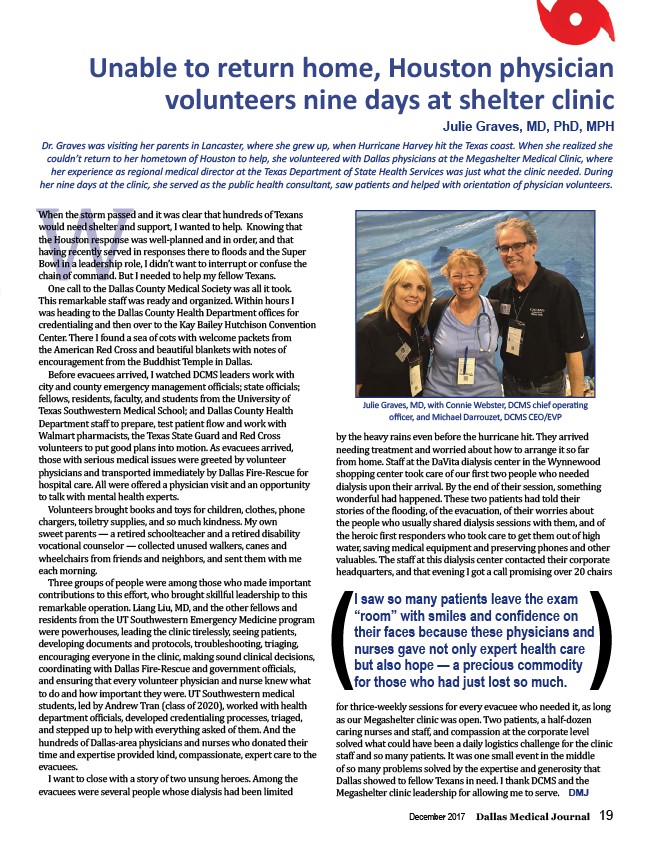
Unable to return home, Houston physician
volunteers nine days at shelter clinic
I saw so many patients leave the exam
“room” with smiles and confi dence on
their faces because these physicians and
nurses gave not only expert health care
but also hope — a precious commodity
for those who had just lost so much. ( )
December 2017 Dallas Medical Journal 19
WWhen the storm passed and it was clear that hundreds of Texans
would need shelter and support, I wanted to help. Knowing that
the Houston response was well-planned and in order, and that
having recently served in responses there to ��loods and the Super
Bowl in a leadership role, I didn’t want to interrupt or confuse the
chain of command. But I needed to help my fellow Texans.
One call to the Dallas County Medical Society was all it took.
This remarkable staff was ready and organized. Within hours I
was heading to the Dallas County Health Department of��ices for
credentialing and then over to the Kay Bailey Hutchison Convention
Center. There I found a sea of cots with welcome packets from
the American Red Cross and beautiful blankets with notes of
encouragement from the Buddhist Temple in Dallas.
Before evacuees arrived, I watched DCMS leaders work with
city and county emergency management of��icials; state of��icials;
fellows, residents, faculty, and students from the University of
Texas Southwestern Medical School; and Dallas County Health
Department staff to prepare, test patient ��low and work with
Walmart pharmacists, the Texas State Guard and Red Cross
volunteers to put good plans into motion. As evacuees arrived,
those with serious medical issues were greeted by volunteer
physicians and transported immediately by Dallas Fire-Rescue for
hospital care. All were offered a physician visit and an opportunity
to talk with mental health experts.
Volunteers brought books and toys for children, clothes, phone
chargers, toiletry supplies, and so much kindness. My own
sweet parents — a retired schoolteacher and a retired disability
vocational counselor — collected unused walkers, canes and
wheelchairs from friends and neighbors, and sent them with me
each morning.
Three groups of people were among those who made important
contributions to this effort, who brought skillful leadership to this
remarkable operation. Liang Liu, MD, and the other fellows and
residents from the UT Southwestern Emergency Medicine program
were powerhouses, leading the clinic tirelessly, seeing patients,
developing documents and protocols, troubleshooting, triaging,
encouraging everyone in the clinic, making sound clinical decisions,
coordinating with Dallas Fire-Rescue and government of��icials,
and ensuring that every volunteer physician and nurse knew what
to do and how important they were. UT Southwestern medical
students, led by Andrew Tran (class of 2020), worked with health
department of��icials, developed credentialing processes, triaged,
and stepped up to help with everything asked of them. And the
hundreds of Dallas-area physicians and nurses who donated their
time and expertise provided kind, compassionate, expert care to the
evacuees.
I want to close with a story of two unsung heroes. Among the
evacuees were several people whose dialysis had been limited
Julie Graves, MD, PhD, MPH
Dr. Graves was visiti ng her parents in Lancaster, where she grew up, when Hurricane Harvey hit the Texas coast. When she realized she
couldn’t return to her hometown of Houston to help, she volunteered with Dallas physicians at the Megashelter Medical Clinic, where
her experience as regional medical director at the Texas Department of State Health Services was just what the clinic needed. During
her nine days at the clinic, she served as the public health consultant, saw pati ents and helped with orientati on of physician volunteers.
Julie Graves, MD, with Connie Webster, DCMS chief operati ng
offi cer, and Michael Darrouzet, DCMS CEO/EVP
by the heavy rains even before the hurricane hit. They arrived
needing treatment and worried about how to arrange it so far
from home. Staff at the DaVita dialysis center in the Wynnewood
shopping center took care of our ��irst two people who needed
dialysis upon their arrival. By the end of their session, something
wonderful had happened. These two patients had told their
stories of the ��looding, of the evacuation, of their worries about
the people who usually shared dialysis sessions with them, and of
the heroic ��irst responders who took care to get them out of high
water, saving medical equipment and preserving phones and other
valuables. The staff at this dialysis center contacted their corporate
headquarters, and that evening I got a call promising over 20 chairs
for thrice-weekly sessions for every evacuee who needed it, as long
as our Megashelter clinic was open. Two patients, a half-dozen
caring nurses and staff, and compassion at the corporate level
solved what could have been a daily logistics challenge for the clinic
staff and so many patients. It was one small event in the middle
of so many problems solved by the expertise and generosity that
Dallas showed to fellow Texans in need. I thank DCMS and the
Megashelter clinic leadership for allowing me to serve. DMJ